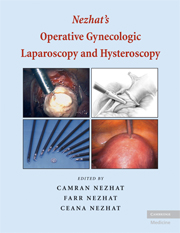Book contents
- Frontmatter
- Contents
- Contributing Authors
- Forewords
- Preface
- 1 HISTORY OF MODERN OPERATIVE LAPAROSCOPY
- 2 EQUIPMENT
- 3 ANESTHESIA
- 4 LAPAROSCOPIC ACCESS
- 5 LAPAROSCOPIC SUTURING
- 6 INTRAPERITONEAL AND RETROPERITONEAL ANATOMY
- 7 FERTILITY
- 8 HYSTEROSCOPY
- 9 MANAGEMENT OF ADNEXAL MASSES
- 10 ENDOMETRIOSIS
- 11 LAPAROSCOPIC ADHESIOLYSIS AND ADHESION PREVENTION
- 12 LEIOMYOMAS
- 13 HYSTERECTOMY
- 14 PELVIC FLOOR
- 15 LAPAROSCOPIC TREATMENT OF CHRONIC PELVIC PAIN
- 16 GYNECOLOGIC MALIGNANCY
- 17 LAPAROSCOPY IN THE PREGNANT PATIENT
- 18 MINIMAL ACCESS PEDIATRIC SURGERY
- 19 LAPAROSCOPIC VASCULAR SURGERY IN 2007
- 20 COMPLICATIONS IN LAPAROSCOPY
- 21 ADDITIONAL PROCEDURES FOR PELVIC SURGEONS
- 22 LAPAROSCOPY SIMULATORS FOR TRAINING BASIC SURGICAL SKILLS, TASKS, AND PROCEDURES
- 23 ROBOT-ASSISTED LAPAROSCOPY
- 24 HYSTEROSCOPY AND ENDOMETRIAL CANCER
- 25 OVERVIEW OF COMPLICATIONS
- Appendix
- Atlas
- Index
12 - LEIOMYOMAS
Published online by Cambridge University Press: 23 December 2009
- Frontmatter
- Contents
- Contributing Authors
- Forewords
- Preface
- 1 HISTORY OF MODERN OPERATIVE LAPAROSCOPY
- 2 EQUIPMENT
- 3 ANESTHESIA
- 4 LAPAROSCOPIC ACCESS
- 5 LAPAROSCOPIC SUTURING
- 6 INTRAPERITONEAL AND RETROPERITONEAL ANATOMY
- 7 FERTILITY
- 8 HYSTEROSCOPY
- 9 MANAGEMENT OF ADNEXAL MASSES
- 10 ENDOMETRIOSIS
- 11 LAPAROSCOPIC ADHESIOLYSIS AND ADHESION PREVENTION
- 12 LEIOMYOMAS
- 13 HYSTERECTOMY
- 14 PELVIC FLOOR
- 15 LAPAROSCOPIC TREATMENT OF CHRONIC PELVIC PAIN
- 16 GYNECOLOGIC MALIGNANCY
- 17 LAPAROSCOPY IN THE PREGNANT PATIENT
- 18 MINIMAL ACCESS PEDIATRIC SURGERY
- 19 LAPAROSCOPIC VASCULAR SURGERY IN 2007
- 20 COMPLICATIONS IN LAPAROSCOPY
- 21 ADDITIONAL PROCEDURES FOR PELVIC SURGEONS
- 22 LAPAROSCOPY SIMULATORS FOR TRAINING BASIC SURGICAL SKILLS, TASKS, AND PROCEDURES
- 23 ROBOT-ASSISTED LAPAROSCOPY
- 24 HYSTEROSCOPY AND ENDOMETRIAL CANCER
- 25 OVERVIEW OF COMPLICATIONS
- Appendix
- Atlas
- Index
Summary
As more articles debating the prevalence of hysterectomies appear in the lay press and on the Internet, increasing numbers of women are demanding alternative procedures. A recent New York Times article decrying the prevalence of hysterectomies stated that by the age of 60, one in three women in the United States will have had her uterus removed. By comparison, in Italy the figure is one in six, whereas in France, it is one in 18 women. Of the 600,000 hysterectomies performed annually in the United States, one third are done for leiomyomas. This number rises dramatically for women over the age of 40 and for those in certain ethnic groups. For African American women, 61.3% of hysterectomies are done for leiomyomas, and for women in the 45-to-54—year age group, 53% of all hysterectomies, regardless of race, are done for this indication. It is estimated that more than 25% of women over the age of 36 have one or more leiomyomas, with 50% of these being symptomatic.
Uterine leiomyomas (myomas) are benign smooth muscle tumors arising from the myometrium. Despite the fact that myomas are quite common, very little is known about their etiology. They are monoclonal — arising from a single myometrial cell. Different karyotypes of multiple myomas have been found in the same patient.
- Type
- Chapter
- Information
- Nezhat's Operative Gynecologic Laparoscopy and Hysteroscopy , pp. 316 - 340Publisher: Cambridge University PressPrint publication year: 2008

